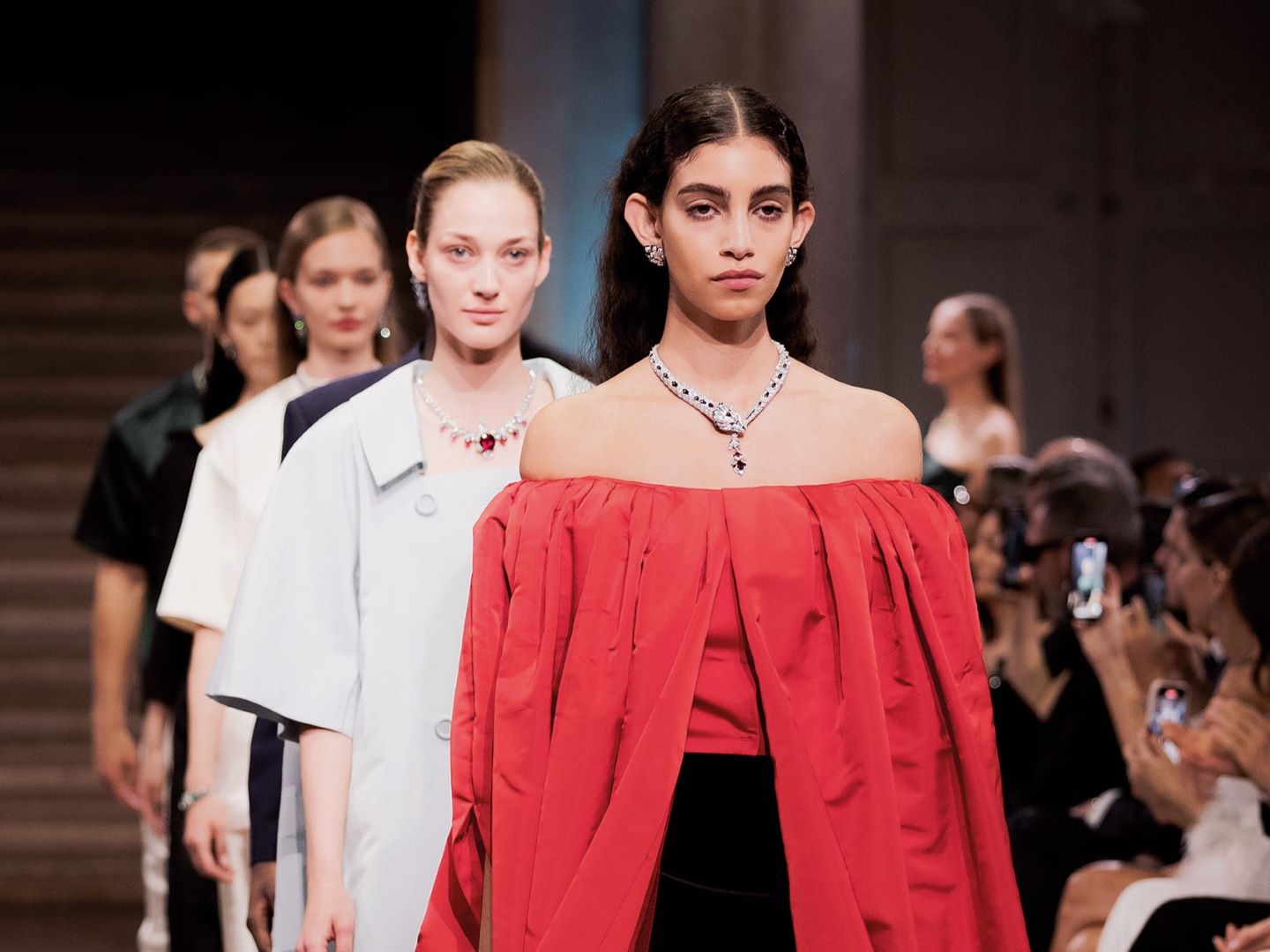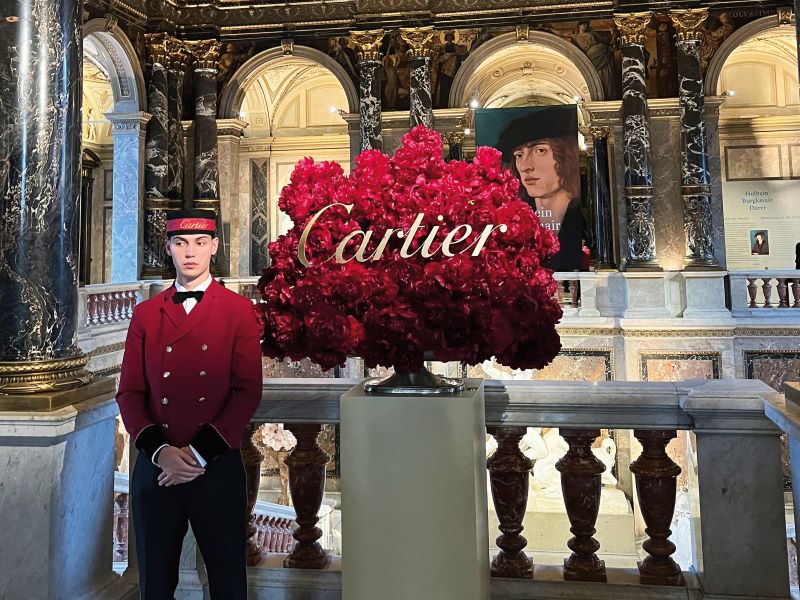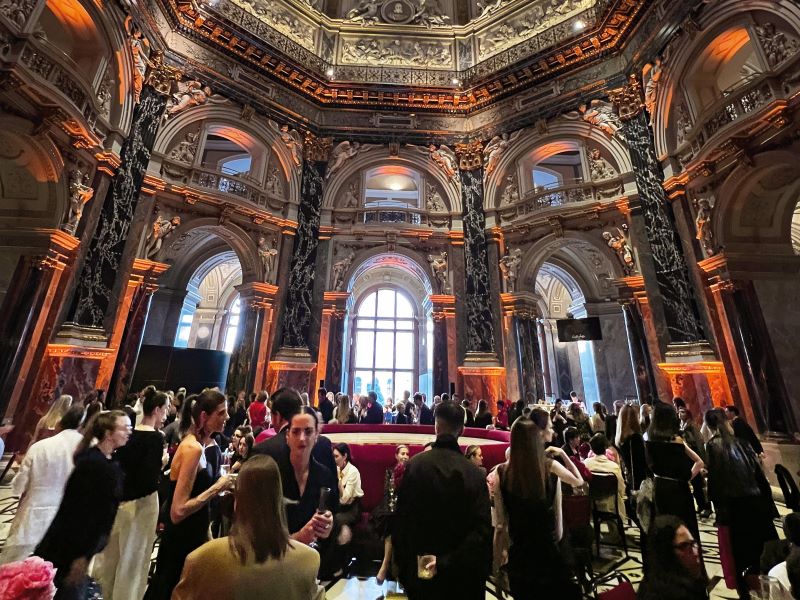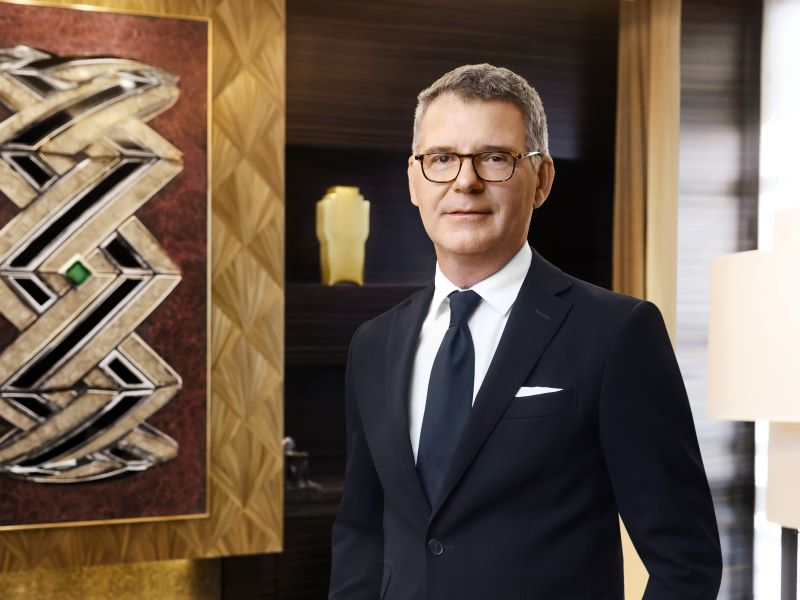
Models presented Nature Sauvage wearing Jonathan Ailwood designs (All photos: Cartier)
Owning fine jewellery is considered a delicious luxury in the best of times. But high jewellery, for want of a better phrase, is in a league of its own, the ultimate expression of exclusivity and timeless elegance. Popularly abbreviated to “HJ” by the top 1% of the world’s elite, it also serves as a lifetime investment that just happens to carry with it centuries of immaculate provenance, extraordinary craftsmanship, heritage, poetic storytelling and, at its (and very beautiful) core, the inimitable magic that only Mother Nature herself can create. After all, despite the popularity of lab-grown whatnot, nothing can take away the allure and rarity of a natural gemstone.
Keeping this in mind, Cartier, owned by luxury conglomerate Richemont, decided to showcase its most dazzling collection of high jewellery to date in the fresh yet obvious choice of Vienna, the former epicentre of power for the Habsburg dynasty for almost four centuries. Using the Austrian capital as a backdrop against which to present bejewelled suites of jewellery and precious objects, in hindsight, makes perfect sense. The old imperial seat whose territories encompassed not just Austria and Hungary but also Bohemia, Croatia, Slovenia, Slovakia and parts of Poland and Romania is surrounded by everything that embraces and underscores palatial luxury. There is the Kaiserliche Schatzkammer (Imperial Treasury) at the Hofburg, royal apartments, a veritable slew of palaces and more.
img_2278.jpg

“Vienna is a very rich European capital in terms of culture,” says Pierre Rainero, Cartier’s image, style and heritage director. “It has a sense of depth, an evocative power of the city’s aspects that makes you feel nothing is there by chance … but built of and to a certain vision. Full of history, art and culture, the Viennese themselves have a wonderful way of enjoying life … something which we feel quite close to at Cartier.”
For the unveiling of its new high jewellery collection, aptly named Nature Sauvage, Cartier selected the Kursalon Hübner, whose 19th-century Renaissance opulence was transformed into three salons with distinctively organic themes of wind, land and water (materials such as wood from the Indre-et-Loire region of France were used and a small army of weavers flown in to create a stunning wicker hut and beds of reeds that seemed to sway with an imaginary breeze) that served as an ideal setting for the glittering jewels.
Drawing from the millennia-old human penchant for representing animals in pictures and drawings, the artisans of Cartier naturally paid homage to what Rainero describes as “a feeling of wildness and majesty”.
img_2277.jpg

“We, as jewellers, understand the power of evocation. Animals were seen as sources of strength and protection and yet also instilled awe.” Certainly one of the most spellbinding creations (if one could choose from a veritable sea of virtuosic designs) from Cartier’s bejewelled bestiary has to be the Panthère des Glaces, a necklace and earrings suite that features a snow leopard, certainly one of the rarest and most beautiful animals in the world, gingerly padding about on a bed of ice crystals and entirely fashioned from diamonds and sapphires. Those who prefer the savannah to the Himalayas might, on the other hand, appreciate the monochromatic mastery embodied in the Koaga, another necklace and earrings set but using diamonds and onyx instead. Here, from the outline of a zebra’s head, dangles a 6.25-carat pear-shaped rubellite. Touches of Oriental inspiration could also be detected in pieces like the Panthère Jaillissante, a bracelet-cum-ring adorned with an 8.63-carat sugarloaf emerald from Zambia, sapphires, emeralds, onyx and brilliant-cut diamonds that bring Moghul India’s glorious haath phool (hand jewels) to mind.
Once night fell, guests were ferried to the Kunsthistorisches Museum, home to remarkable works of art spanning ancient Egypt to Gustav Klimt and Vermeer, to unwind under its impressive cupola hall, accompanied by melodies from the world-renowned Vienna Boys Choir, who sang jaunty favourites like Wellerman and I Bin A Steirerbua.
cartier_gala_press_vienne_2024_-_sai_-_stephane_ait_ouarab_2024-116.jpg

For the gala evening, the 160-year-old Museum für Angewandte Kunst (abbreviated to MAK, and known as the Museum of Applied Arts in English) was chosen. There, a series of visual and other sensorial treats were laid out for those gathered to see, experience and enjoy, including the Viennese waltz and a special runway show featuring fashions by Jonathan Ailwood matched with Cartier’s exceptional bijoux. Naturally, a bevy of luminaries, like film director Sofia Coppola, actor Elle Fanning and aristocratic socialite Bianca Brandolini d’Adda who, through her father, can trace the family lineage back to the formidable Empress Maria Theresa of Austria, were in attendance. Guests were then ushered upstairs for dinner, a special feast prepared by Juan Amador. The renowned chef behind the eponymous Amador travelled from his restaurant, which boasts three Michelin stars and is nestled within a working winery at the foothills of Vienna, to the city especially for the event. During dinner, a choreographed performance by Arthur Cadre and recital of Dein ist mein ganzes Herz, an aria from the 1929 operetta Das Land des Lächelns by Italian tenor Fabio Sartori, added to the layers of luxurious amusement. Bringing the night to a soulful close was a performance by Brit Award-winning artiste Raye, flown in from London for the occasion.
That night, punctuated by the music of a string ensemble playing classics by Lanner and Strauss, Cartier gave another hint as to why Vienna was handpicked as the city in which to present Nature Sauvage. Rainero, keeper of the maison’s heritage and history, reveals a small but poignant connection between the two. Louis Cartier, who married the Hungarian Countess Jacqueline Almásy in 1924, had bought his beautiful new bride a palace in Budapest and often travelled through the Austrian capital en route from Paris. “We still have Louis’ passport, filled with stamps as he passed through Paris, Munich and Vienna to get to Budapest,” says Rainero.
pierre_rainero_281_rvb_04.jpg

How fitting then for Cartier, known as the “King of Jewellers and the Jeweller of Kings” to select one of Europe’s most perfectly formed jewel boxes of a city, infused with the elegance and grandeur of a royal past, to unveil a collection of creations fit for any modern-day maharajah. Austria’s beloved Empress Sisi had once said Vienna’s beauty could be “found in every detail”. This truth now extends to one of the most incredible presentations of high jewellery in the world to date.
MAD FOR MODULAR
Yes, high jewellery is attainable only by the top 1% of the global elite but that doesn’t mean the eye-wateringly expensive pieces can or should only be worn one way. Here is our pick of the five most versatile designs from the Nature Sauvage collection by Cartier. More is more, we say.
Madave
Transforming from a sautoir necklace into a headband, this Art Deco-meets- Orientalism creation boasts a 6.01-carat sugarloaf-cut emerald from Zambia accented by baguette-cut, brilliant-cut, half-moon and rectangular diamonds, sugarloaf coral, emerald and coral beads, coral drops and onyx.
Imperio
One of the most versatile pieces in the entire collection, the Imperio offers a dizzying array of possibilities, including necklace options. One of the triangular motifs is detachable, enabling it to be worn as a brooch. Its heart, of course, beats with an unmissable 23.55-carat octagonal Colombian emerald.
Carelie
Borrowing its name from the Karelia, a Russian region covered by the Taiga forest, the Carelie necklace can be converted into a ring and vice versa. The single central 13.08-carat cushion-shaped Kashmiri sapphire may be interchanged with a D IF diamond motif ring that can be worn either on the necklace or the ring.
Spina
Worn as a necklace or, more dazzlingly, a tiara, thanks to the inclusion of an additional mount, the choice is deliciously yours with the Spina, a geometric piece whose name is inspired by spina di pesce, which means “chevron” in Italian, echoing the design. There are three remarkable centre stones, including a rare 29.16-carat Ceylon sapphire and two diamonds which total 4.56 carats.
Memini
Its name stems from the Latin for “remember” but this ensemble of octagonal and pear-shaped tourmalines totaling 19.28 carats can be worn for the stones’ ability to inspire enlightenment and balance as well. The wearer has the option to wear front or back for versatility and what makes this suite exceedingly engaging are the soothing blue-green hues of the stone.
This article first appeared on June 17, 2024 in The Edge Malaysia.







